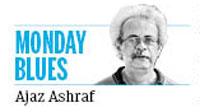A recent report on representation of the marginalised in media underscores the profound words of a Dalit journalist: Like the bitter gourd, I twirled around the neem tree to become even more bitter

The first caste survey of Indian media held in 2006 found upper caste Hindus holding 88 per cent of leadership positions. It currently stands at 88.1 per cent. Representation pic
 It is time to evolve a social diversity index for media outlets, or a measure to gauge the caste heterogeneity of their employees. It should be made mandatory for the Central and state governments to refer to such an index before they issue advertisements. Tax breaks should be given to corporates and individuals either advertising with or donating money to media outlets that rank in the top 20 on the social diversity scale.
It is time to evolve a social diversity index for media outlets, or a measure to gauge the caste heterogeneity of their employees. It should be made mandatory for the Central and state governments to refer to such an index before they issue advertisements. Tax breaks should be given to corporates and individuals either advertising with or donating money to media outlets that rank in the top 20 on the social diversity scale.
These measures could help socially diversify Indian media, which is dominated by upper-caste journalists. This is vividly brought out by the 2022 Oxfam India-Newslaundry report—Who tells our stories matters: Representation of Marginalised Caste Groups in Indian Media. Their survey shows that 88.1 per cent of leadership positions in the media—editor-in-chief, managing editor, executive editor, bureau chief, resident editor, director and producer—were held by the upper castes. In contrast, the presence of the Other Backward Classes dipped from 4.06 per cent in 2019 to 3.57 per cent in 2022.
Scheduled Castes holding leadership positions grew from 0 per cent in 2019 to 3.17 per cent in 2022, and the Scheduled Tribes from 0 per cent in 2019 to 0.4 per cent in 2022. This insignificant increase seemed to have been driven by SC and ST journalists floating their own outfits in the digital space, where they together hold nearly 14 per cent of leadership positions.
Even more worryingly, caste representation in Indian media has not changed much since 2006, when social scientist Yogendra Yadav and journalists Anil Chamadia and Jitendra Kumar carried out the first caste survey of Indian media. They found upper-caste Hindus holding 88 per cent of leadership positions in 40 media outlets. Not a single media leader had a Dalit or Adivasi background. The rate of social change in the media more than matches the “Hindu rate of growth” that had earlier dogged the economy.
Journalist B N Uniyal was the first to train the spotlight on caste in Indian media, through his piece In Search of a Dalit Journalist, which was published in The Pioneer on November 16, 1996. A foreign reporter had asked Uniyal for an introduction to a Dalit journalist. Uniyal realised he did not know one. He analysed 454 caste surnames of 686 journalists accredited by the Press Information Bureau. There was not a single Dalit among them. He called up 47 of the remaining 232 accredited journalists—and still drew a blank.
To celebrate the dawn of the new millennium, The Pioneer invited Uniyal to write for its eight-page Dalit supplement. He sent them the 1996 piece with the following addition: “The article…was totally ignored by our journalistic establishment… None felt aghast or alarmed at the situation described in the article.”
I was reminded of Uniyal’s article during a visit to Delhi’s Indian Institute of Mass Communication in 2013. A government institute, it has had reservation for decades. Why was it, then, that Uniyal could not locate a single Dalit journalist? With the help of Sunit Tandon, then the IIMC director, I tracked 22 Dalits who had studied at the IIMC.
I did a three-part series for The Hoot: The untold story of Dalit journalists, Caste on the campus, Farewell to media dreams. My conclusions were: Many Dalits enter the media in the hope of empowering their community; they have a greater presence in the Hindi and other languages media than the English media; caste-based antagonism and discrimination are more rampant in the former category of media outlets than the latter; their experience of discrimination is a crucial factor behind their decision to quit journalism; and they prefer government jobs (Doordarshan, for instance) as their weak economic base makes them averse to the privately owned media, where jobs are rarely permanent.
These findings were distilled from the heartbreaking stories of discrimination I heard. I particularly remember Ashok Das, who now heads his own outfit, Dalit Dastak. He was among the 10 journalists selected for the bureau a Hindi newspaper was establishing at Aligarh. They lived and ate together at a temporary accommodation. One day, his colleagues asked Das what his caste was. He said, “Dalit.”
They said they did not believe in the caste system. Yet none of them wanted to pair with him when it was time for them to move to their own accommodation on rent. A Brahmin, however, broke ranks with the others to do so. Later, he told Das about the furious debate Das had sparked by revealing his caste identity. At work, superseded by laggards, Das resigned. It is his suggestion I have improvised upon in the first para of this piece.
Or take SPG, a Dalit journalist with a Hindi newspaper in an Uttar Pradesh city. For The Hoot series, he said to me, “Like the bitter gourd, I twirled around the neem tree to become even more bitter.” The other day, I asked him whether the 2013 quote still held true for him. SPG laughed and said, “I am still a sub-editor after 15 years.” Hey, Oxfam and Newslaundry, would you give SPG a job in case an opening comes up in the Hindi department? That would be one positive outcome of your fabulous report.
The writer is a senior journalist.
Send your feedback to mailbag@mid-day.com
The views expressed in this column are the individual’s and don’t represent those of the paper.
 Subscribe today by clicking the link and stay updated with the latest news!" Click here!
Subscribe today by clicking the link and stay updated with the latest news!" Click here!










